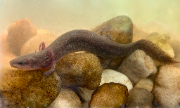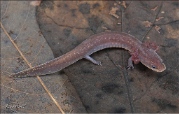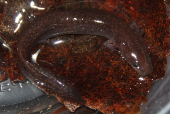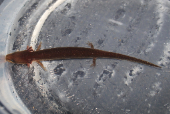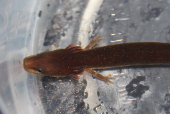|
Dwarf Waterdog (Necturus punctatus)
Description: This species is usually between 4.5 and 7.5 inches long. It has bushy, narrow gills and a compressed tail. All feet have four toes. The salamander is uniform slate gray to brown or dark olive dorsally and dirty white ventrally. Most individuals have no dorsal spots; when the dorsal spots are present, the venter is unspotted (unlike in Necturus lewisi, which is also a larger species). Juveniles are uniformly brown dorsally (as opposed to striped, as in other juvenile Necturus).
Habitat: Dwarf waterdogs live in slow, sand- or mud-bottomed streams and connected ditches, cypress swamps; also stream-fed rice fields and mill ponds. They prefer bottoms with leaf litter and other detritus. During winter juveniles burrow into bottom and adults in leaf beds.
Range: Necturus punctatus is found on the Atlantic coastal plain and the Piedmont of the eastern United States, from southeastern Virginia to southcentral Georgia.
Found in these States:
GA |
NC |
SC |
VA
Diet: There is no information available regarding the mating system of dwarf waterdogs.
Little is know of the reproductive behavior of dwarf waterdogs, however, other waterdog species reproduce aquatically. The larger a dwarf waterdog, the greater the number of oocytes in the ovaries, which contain yolked and unyolked oocytes during mid-autumn. Most pregnant females carry 15 to 55 eggs. Average egg diameter has been reported as 4 and 4.2 mm and may depend on the number of eggs being carried. Prior to mating, which occurs during winter, male testes become large, firm, and yellow with dark pigmentation. Despite gender, individuals reach reproductive maturity by age 5 or when they become 65 to 70 mm in head-body length. Although no nests have been discovered, it is thought that dwarf waters attach their eggs to the underside of logs and other objects in the water
Reproduction: There is no information available regarding the mating system of dwarf waterdogs. Little is know of the reproductive behavior of dwarf waterdogs, however, other waterdog species reproduce aquatically. The larger a dwarf waterdog, the greater the number of oocytes in the ovaries, which contain yolked and unyolked oocytes during mid-autumn. Most pregnant females carry 15 to 55 eggs. Average egg diameter has been reported as 4 and 4.2 mm and may depend on the number of eggs being carried. Prior to mating, which occurs during winter, male testes become large, firm, and yellow with dark pigmentation. Despite gender, individuals reach reproductive maturity by age 5 or when they become 65 to 70 mm in head-body length. Although no nests have been discovered, it is thought that dwarf waters attach their eggs to the underside of logs and other objects in the water
Status: Listed as Least Concern in view of its wide distribution and presumed large population.
»» Kingdom: Animalia - Animals
»» Phylum: Chordata - Chordates
»» Subphylum: Vertebrata - Vertebrates
»» Class: Amphibia - (Amphibians)
»» Order: Caudata - Salamanders
»» Family: Proteidae - Mudpuppies & Olm
»» Genus: Necturus
»» Species: Necturus punctatus - Dwarf Waterdog
This article uses material from the Wikipedia article "Dwarf Waterdog", which is released under the Creative Commons Attribution-Share-Alike License 3.0. Content may have been omitted from the original, but no content has been changed or extended.
|
|




